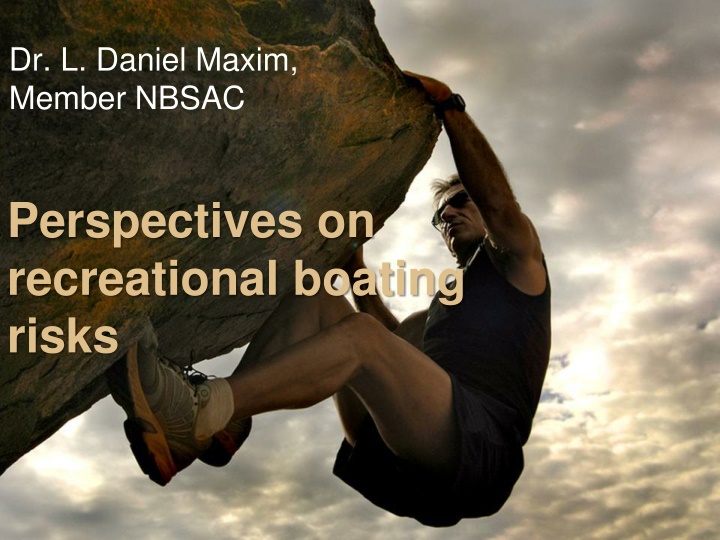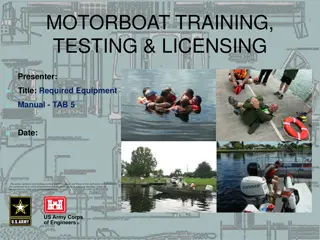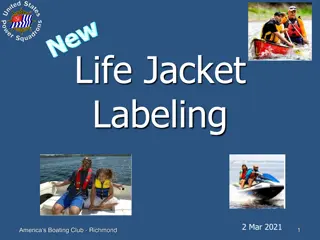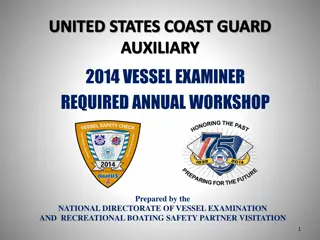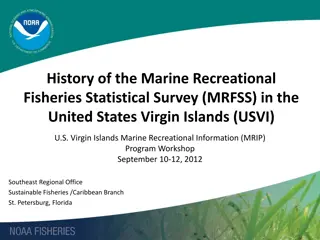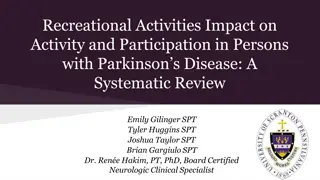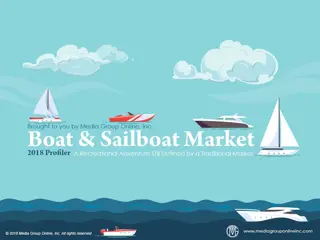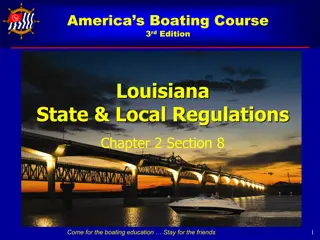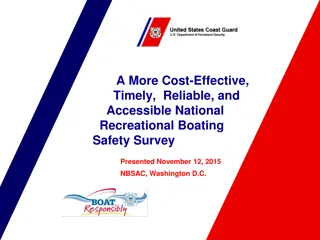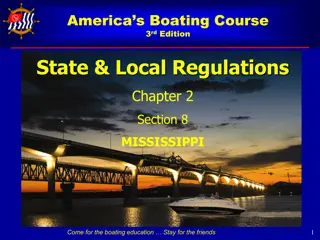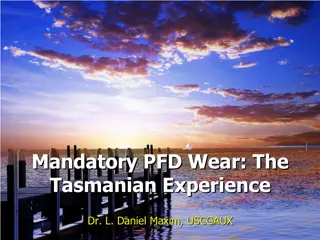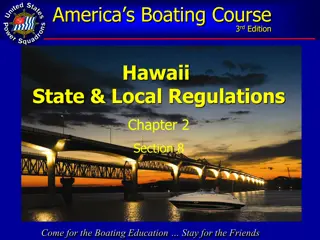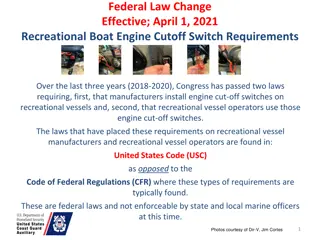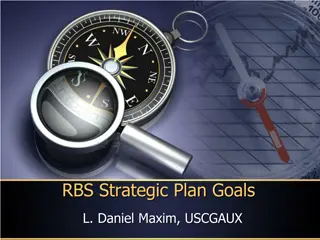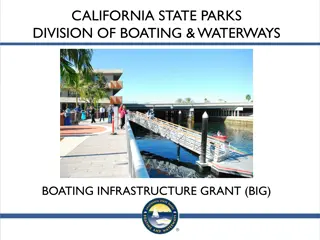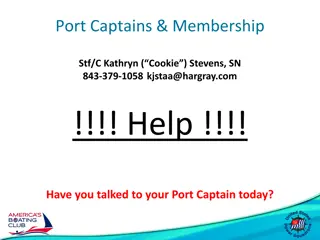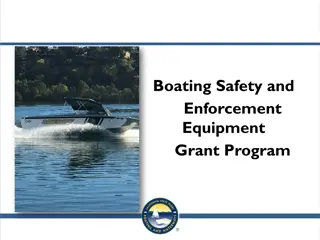Recreational Boating Risks: A Data Analysis Perspective
Exploring recreational boating risks through data analysis, this presentation delves into the significance of converting data into actionable information. It compares fatality rates from boating accidents with other activities, highlighting the importance of informed decision-making based on a comprehensive understanding of risks.
Download Presentation

Please find below an Image/Link to download the presentation.
The content on the website is provided AS IS for your information and personal use only. It may not be sold, licensed, or shared on other websites without obtaining consent from the author.If you encounter any issues during the download, it is possible that the publisher has removed the file from their server.
You are allowed to download the files provided on this website for personal or commercial use, subject to the condition that they are used lawfully. All files are the property of their respective owners.
The content on the website is provided AS IS for your information and personal use only. It may not be sold, licensed, or shared on other websites without obtaining consent from the author.
E N D
Presentation Transcript
Dr. L. Daniel Maxim, Member NBSAC Perspectives on recreational boating risks
Disclaimer Presents results of exploratory data analysis (EDA) further analyses may alter these estimates Findings and conclusions are those of the author only and do not necessarily represent views of NBSAC or the United States Coast Guard 2
Presentation Agenda Background From data to information Normalization Fatality rate calculations Concluding comments 3
Background Need to make sense of boating accident/injury/fatality data collected as part of analyses of: BARD data on boating accidents National Recreational Boating Safety Survey (NRBSS) NBSAC interests and member requests NASBLA ERAC continuing studies Why focus on fatalities rather than accidents or casualties? 4
The basic paradigm DATA INFORMATION KNOWLEDGE INFORMED ACTION 5
First key objective: converting data into information In 2012, 651 persons died in recreational boating accidents How should we interpret this fact? Compare it with fatalities in previous years? Compare it to fatalities from other causes or activities? Compare it with other fatality rates and, if so, How should these rates be calculated? What other activities should be included for comparison? 6
Large (92%) compared to other marine transportation fatalities Recreational boating Commercial fishing Commercial passengers Cargo transport 8 NTSB Data for 2012
But small compared to highway fatalities 9
These comparisons useful, but Fail to consider the number of people potentially exposed to risk Solution: adjust for population at risk Fail to consider the actual exposure of participants Solution: adjust for individual exposures 10
Normalization Mathematical adjustment of fatality data to provide a more relevant measure for comparison Appropriate basis for normalization depends upon purpose(s) of analysis Example: highway and boating fatalities in 2012 Boating 651 fatalities Highway 33,782 fatalities 11
Comparisons Raw data Annual highway fatalities ~52 times greater than boating fatalities Annual fatalities per participant Highway: 33,782 fatalities among 314.1 million persons = 1 in 9,298 Boating: 651 among 74.5 million persons = 1 in 114,439, so boating safer than highway by factor of 12.3 12
Comparisons (continued) Fatalities per exposure hour: Highway: 0.42 fatalities per million vehicle exposure hours Boating: ~0.44 fatalities per million boat exposure hours Most experts believe that exposure hours are the best basis for normalization a key justification for the NRBSS focus on collecting these data 13
Other denominators in use Ton miles (freight) Fatalities per participant per year Vehicle miles (automobiles) Passenger miles (commercial aircraft) Vehicle hours (various) Passenger hours (various) Hours (individual sports) 14
Fatality rate calculations Represent averages, not necessarily risks for any single individual Data quality and probable accuracy vary by activity Just exactly what is an exposure hour? Pool annual data to smooth out fluctuations? Risk Ladder 15
Comparisons: activities with higher risks Activity Fatalities per million exposure hours BASE jumping Sky diving Hang gliding General aviation Motorcycles Scuba diving Pedestrian Swimming Snowmobiling Bicycling Commercial fishing 12,948.00 75.89 25.86 22.44 Draft Subject to revision 8.40 6.29 1.26 1.07 0.88 0.57 0.51 16
Comparisons: activities with lower risks Activity Fatalities per million exposure hours Recreational boating Highway ATVs Skiing Working in agriculture Train travel (passengers) Bus travel (passengers) Wholesale trade Government (non-military) Retail trade 0.44 0.42 0.38 0.14 0.128 0.055 0.035 0.025 0.014 0.010 17
With all due respect sir/maam, just exactly what were you thinking? 18
Challenges to developing valid risk comparisons Data gaps (typically valid exposure data) Possible data biases Heterogeneity of activities (mountain climbing your local hill or Mount Everest) Lack of supporting detail in some reported risk estimates We are continuing to improve these preliminary estimates (EDA) before going final 19
State-by-state data Substantial interest in disaggregated analyses by states Challenges/issues include: Small sample sizes for many states: pool years? Differences between state where fatalities occurred and state of residence of boater Analysis continuing as part of ERAC charge 20
Concluding comments Historically fatality rates in USCG publications based on the number of registered boats Although convenient and readily available, this measure Does not include all boats Does not capture exposure differences among boat types Cannot readily be compared with fatality rates for other activities 21
Concluding comments Exposure hours (boat or person) a reasonable basis for comparison Key data on exposure hours collected by NRBSS Status and plans for future surveys were covered yesterday in Dr. Mahoney s presentation 22
Concluding comments Risk ladder ideas helps put fatality rates into more meaningful perspective We are continuing to improve these estimates Based on these calculations, boating is a relatively safe activity: Comparable on an exposure hour basis to overall highway fatality rates and certainly lower than extreme sports 23
Concluding comments Nonetheless, boating accidents remain an important concern; Social costs are substantial (fatalities, injuries, and property damage) Most are avoidable with relatively simple measures, such as wearing life jackets Continuing need to foster a robust safety culture among recreational boaters USCG fully committed to making boating safer 24
Questions 25
